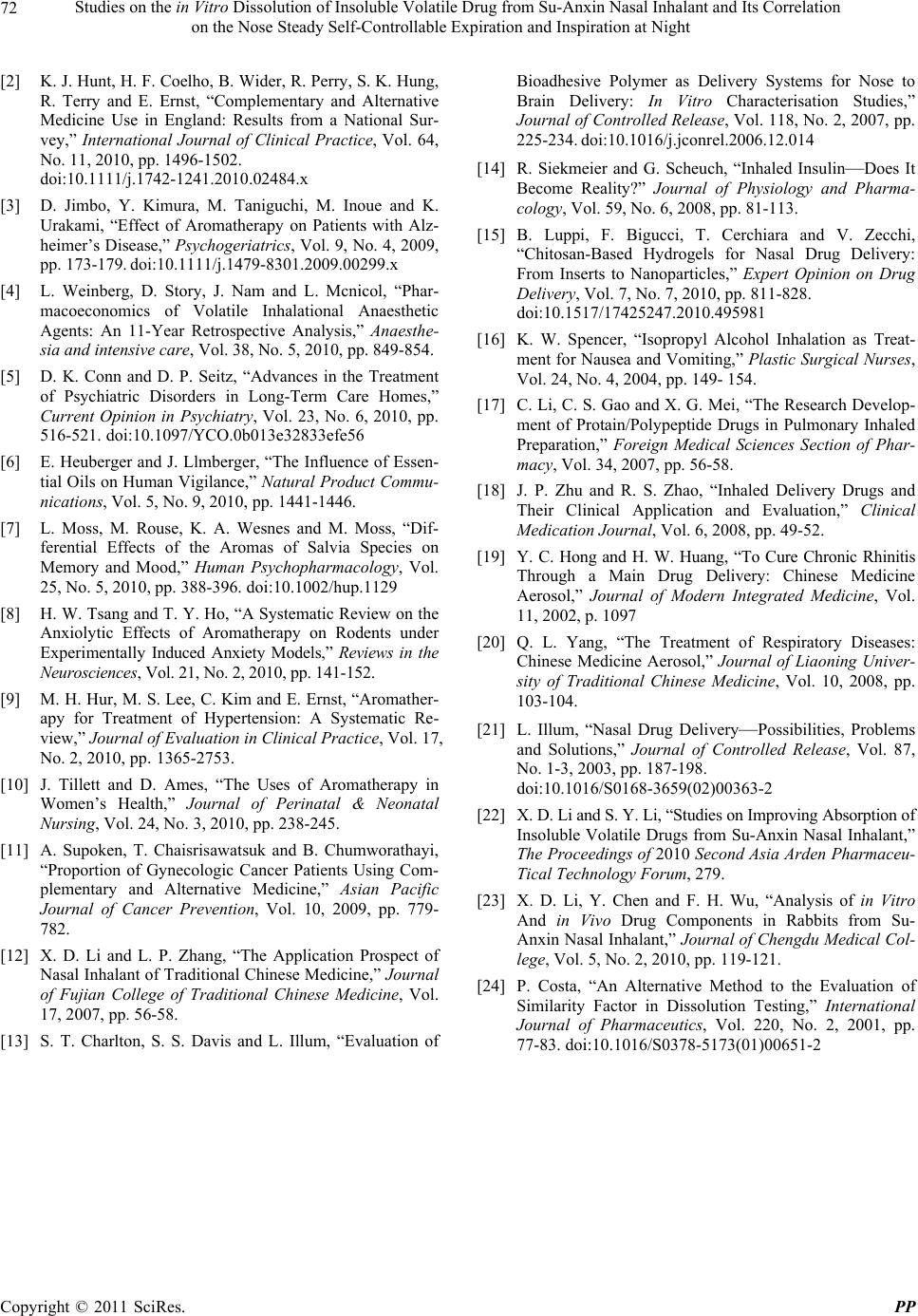
Studies on the in Vitro Dissolution of Insoluble Volatile Drug from Su-Anxin Nasal Inhalant and Its Correlation
on the Nose Steady Self-Controllable Expiration and Inspiration at Night
Copyright © 2011 SciRes. PP
72
2.
[2] K. J. Hunt, H. F. Coelho, B. Wider, R. Perry, S. K. Hung,
R. Terry and E. Ernst, “Complementary and Alternative
Medicine Use in England: Results from a National Sur-
vey,” International Journal of Clinical Practice, Vol. 64,
No. 11, 2010, pp. 1496-1502.
doi:10.1111/j.1742-1241.2010.02484.x
[3] D. Jimbo, Y. Kimura, M. Taniguchi, M. Inoue and K.
Urakami, “Effect of Aromatherapy on Patients with Alz-
heimer’s Disease,” Psychogeriatrics, Vol. 9, No. 4, 2009,
pp. 173-179. doi:10.1111/j.1479-8301.2009.00299.x
[4] L. Weinberg, D. Story, J. Nam and L. Mcnicol, “Phar-
macoeconomics of Volatile Inhalational Anaesthetic
Agents: An 11-Year Retrospective Analysis,” Anaesthe-
sia and intensive care, Vol. 38, No. 5, 2010, pp. 849-854.
[5] D. K. Conn and D. P. Seitz, “Advances in the Treatment
of Psychiatric Disorders in Long-Term Care Homes,”
Current Opinion in Psychiatry, Vol. 23, No. 6, 2010, pp.
516-521. doi:10.1097/YCO.0b013e32833efe56
[6] E. Heuberger and J. Llmberger, “The Influence of Essen-
tial Oils on Human Vigilance,” Natural Product Commu-
nications, Vol. 5, No. 9, 2010, pp. 1441-1446.
[7] L. Moss, M. Rouse, K. A. Wesnes and M. Moss, “Dif-
ferential Effects of the Aromas of Salvia Species on
Memory and Mood,” Human Psychopharmacology, Vol.
25, No. 5, 2010, pp. 388-396. doi:10.1002/hup.1129
[8] H. W. Tsang and T. Y. Ho, “A Systematic Review on the
Anxiolytic Effects of Aromatherapy on Rodents under
Experimentally Induced Anxiety Models,” Reviews in the
Neurosciences, Vol. 21, No. 2, 2010, pp. 141-152.
[9] M. H. Hur, M. S. Lee, C. Kim and E. Ernst, “Aromather-
apy for Treatment of Hypertension: A Systematic Re-
view,” Journal of Evaluation in Clinical Practice, Vol. 17,
No. 2, 2010, pp. 1365-2753.
[10] J. Tillett and D. Ames, “The Uses of Aromatherapy in
Women’s Health,” Journal of Perinatal & Neonatal
Nursing, Vol. 24, No. 3, 2010, pp. 238-245.
[11] A. Supoken, T. Chaisrisawatsuk and B. Chumworathayi,
“Proportion of Gynecologic Cancer Patients Using Com-
plementary and Alternative Medicine,” Asian Pacific
Journal of Cancer Prevention, Vol. 10, 2009, pp. 779-
782.
[12] X. D. Li and L. P. Zhang, “The Application Prospect of
Nasal Inhalant of Traditional Chinese Medicine,” Journal
of Fujian College of Traditional Chinese Medicine, Vol.
17, 2007, pp. 56-58.
[13] S. T. Charlton, S. S. Davis and L. Illum, “Evaluation of
Bioadhesive Polymer as Delivery Systems for Nose to
Brain Delivery: In Vitro Characterisation Studies,”
Journal of Controlled Release, Vol. 118, No. 2, 2007, pp.
225-234. doi:10.1016/j.jconrel.2006.12.014
[14] R. Siekmeier and G. Scheuch, “Inhaled Insulin—Does It
Become Reality?” Journal of Physiology and Pharma-
cology, Vol. 59, No. 6, 2008, pp. 81-113.
[15] B. Luppi, F. Bigucci, T. Cerchiara and V. Zecchi,
“Chitosan-Based Hydrogels for Nasal Drug Delivery:
From Inserts to Nanoparticles,” Expert Opinion on Drug
Delivery, Vol. 7, No. 7, 2010, pp. 811-828.
doi:10.1517/17425247.2010.495981
[16] K. W. Spencer, “Isopropyl Alcohol Inhalation as Treat-
ment for Nausea and Vomiting,” Plastic Surgical Nurses,
Vol. 24, No. 4, 2004, pp. 149- 154.
[17] C. Li, C. S. Gao and X. G. Mei, “The Research Develop-
ment of Protain/Polypeptide Drugs in Pulmonary Inhaled
Preparation,” Foreign Medical Sciences Section of Phar-
macy, Vol. 34, 2007, pp. 56-58.
[18] J. P. Zhu and R. S. Zhao, “Inhaled Delivery Drugs and
Their Clinical Application and Evaluation,” Clinical
Medication Journal, Vol. 6, 2008, pp. 49-5
[19] Y. C. Hong and H. W. Huang, “To Cure Chronic Rhinitis
Through a Main Drug Delivery: Chinese Medicine
Aerosol,” Journal of Modern Integrated Medicine, Vol.
11, 2002, p. 1097
[20] Q. L. Yang, “The Treatment of Respiratory Diseases:
Chinese Medicine Aerosol,” Journal of Liaoning Univer-
sity of Traditional Chinese Medicine, Vol. 10, 2008, pp.
103-104.
[21] L. Illum, “Nasal Drug Delivery—Possibilities, Problems
and Solutions,” Journal of Controlled Release, Vol. 87,
No. 1-3, 2003, pp. 187-198.
doi:10.1016/S0168-3659(02)00363-2
[22] X. D. Li and S. Y. Li, “Studies on Improving Absorption of
Insoluble Volatile Drugs from Su-Anxin Nasal Inhalant,”
The Proceedings of 2010 Second Asia Arden Pharmaceu-
Tical Technology Forum, 279.
[23] X. D. Li, Y. Chen and F. H. Wu, “Analysis of in Vitro
And in Vivo Drug Components in Rabbits from Su-
Anxin Nasal Inhalant,” Journal of Chengdu Medical Col-
lege, Vol. 5, No. 2, 2010, pp. 119-121.
[24] P. Costa, “An Alternative Method to the Evaluation of
Similarity Factor in Dissolution Testing,” International
Journal of Pharmaceutics, Vol. 220, No. 2, 2001, pp.
77-83. doi:10.1016/S0378-5173(01)00651-2